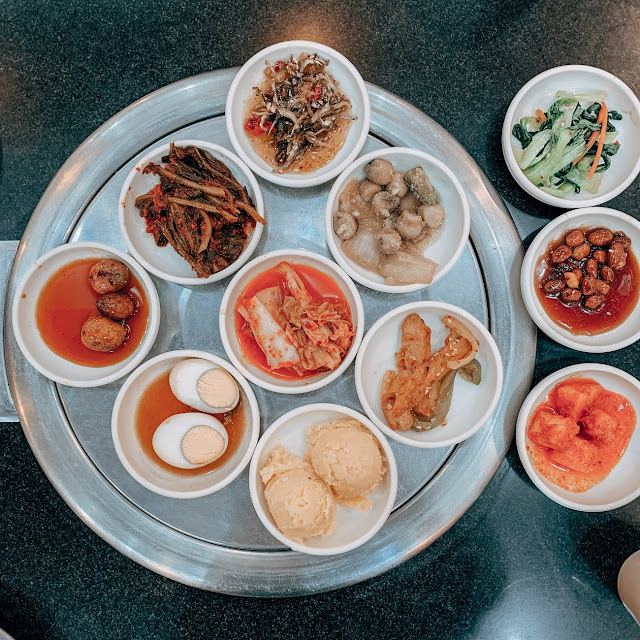Featured
- Get link
- X
- Other Apps
What do Koreans Eat? Famous Korean Cuisine by Region
How is South Korean Food Different than American Food?
Get into the core of the Korean food culture by trying kimchi jjigae (kimchi stew), bibimbap (mixed rice), kal gooksoo (knife-cut noodles), kalbi tang (kalbi soup), kimchi, kimbap, bulgogi, bibim guksu.
Korean cuisine varies by region depending on the environment and what is naturally found in the regions. Of course, socio-economic factors will also create differences in diet (i.e. working class or ruling class).
The north is a mountainous region, and they tend to eat salted or dried fish, seaweed, and mountain plants. Because of the mountainous terrain, wet farming (how rice is farmed) is not always a viable option, and so they dry-field farm and grow cereal crops.
The Central and Southern regions geographically consist mostly of plains, therefore they grow more rice crops, and the coastal region cuisine consists of fresh fish, shellfish and seaweed. There are 9 main provinces in Korea, each with a very unique story told by their food. They tend to overlap and influence one another.
The nine provinces of South Korea are:
- North Chungcheong
- South Chungcheong
- Gangwon
- Gyeonggi
- North Gyeongsang
- South Gyeongsang
- North Jeolla
- South Jeolla
- Jeju Special Self-Governing Province
North Korean food varies even more, but we'll focus on South Korea in this article.
The Cuisine South Korea's Central Region (Seoul), or Korea's Royal Cuisine
The cuisine of the Central region is influenced by Seoul, which historically was the administrative center. Therefore, Seoul's cuisine tended to be luxurious and rich in flavor due to the use of royal ingredients. This area has many different regional delicacies that are prepared with their unique sauces for kimchi.
Seoul has been the capital of Korea for 600+ years, and so even today the food is influenced by the traditional royal court. They tend to serve a variety of small attractive dishes and favor a high quality/lower quantity philosophy. Traditional dishes from this region include ox bone soup, a platter of nine delicacies, and mung bean jelly with veggies and beef.
Gyeonggi Province's Culinary History
This cuisine tends to have many seafood dishes. They are characterized by kimchi that is mild with less garlic, and kal gook soo (knife-cut noodles).
The Gyeonggi Province is located in Northern South Korea. Here the local food style is plane and simple, yet diverse. The food is moderately salty and considering the proximity to Seoul, it is similar to the food from there. Spices are used in moderation. Historically, there was a cattle market located in Suwon, and this led to an increased popularity of barbecue beef.
Food from ChungCheong Province
The ChungCheong Province is located in Central South Korea, and here you'll find kimchi is extra spicy. Their cuisine focuses more on the preparation of raw seafood, and focuses on fresh and fermented flavors, with a large amount of spice.
The ChungCheong Province is south of the Gyeonggi Province and is located in the central region of the country. Their cuisine features salted fish due to its increased preservation, as well as easily found mountain herbs and vegetables.
The food is very lightly seasoned, allowing the natural flavor of the food to be enjoyed. Freshwater shellfish (olgoengi) and oysters are prominent in the food.
Culinary Promise of Gangwon Province
Located in the Northeast region of South Korea, Gangwon food is fresh and healthy.
Gangwon Province borders North Korea and the East Sea, it also is a province that tends to favor dry farming due to its mountainous terrain. This means that corn, buckwheat, and potatoes (as well as acorns and wild veggies) are regulars in recipes from this area.
The proximity to the sea allows for dried and salted Pollock, squid, and seaweed to make its way to the dinner table. Gangwon potatoes are found in dishes steamed or fermented. Sujebi, (a soup with pulled dough morsels), porridge, and half-moon rice cakes are unique dishes prevalent in this region.
The kimchi served in Korea also differs by region. A kimchi recipe from the north tends to be saltier, sweeter, and spicier than kimchi recipes elsewhere. There are countless kimchi varieties, including some kimchis that are exclusive to just one village or town.
Traditional Food from Jeolla Province
Jeolla Province is located in the southwest of South Korea.
Kimchi from this region tends to be right down the middle- not too spicy and slightly sweet. They make kimchi with both red pepper powder and chili flakes, allowing them to make kimchi that has a different flavor depending on regions they sell it in.
Jeolla is located in the south and is bordered by the West and South Sea. It is rich in natural resources, and the food tends to be lavish with extravagant food preparation. Traditionally this province has been home to nobles. The climate in this area is warm, so the food is salty, spicy, and pungent. Dishes include Gatssam Kimchi, Godulppaengiji, fermented thornback and bibimbap are all common dishes from this area.
Food from Gyeongsang Province
The Gyeongsang Province is in the southeast of South Korea. Their kimchi tends to be less spicy than kimchis made in other regions, and they use grilled beef more often than kalbi (barbecue beef).
Gyeongsang Province is located at the end of the peninsula next to Jeolla Province, but bordering the South Sea and East Sea. They have fertile fishing grounds that are rich in marine products. The Nakalelong River runs through the area making the land fertile for agriculture. The food here is spicy and salty as well, however it is more plain and modest. Herbs and Chinese peppers are found in the food from this region, and Sashimi, Makjong, Dambukjong, and Dongrae Dajeon (a seafood and green onion pancake) are eaten here.
The Food of Jeju Island
Jeju Island is the southernmost island in Korea, therefore it has a warm climate. The island is surrounded with fishing grounds, making fish a prevalent part of Jeju cuisine. Also, since the food is so fresh, few seasonings are used and recipes can be made with only a handful of different ingredients. Dishes from this area include Ojingeo hoe, (오징어회), sliced raw squid made with squid and Sangeo sanjeok, (상어산적), Korean pancakes made with shark.
Jeju Island also is home to kimchi made with crushed red peppers, fish cake soup (malto kuk), and a kimchi marinade made from anchovies.
Although varied and diverse, the regional cuisines of Korea work together to form a picture of the history of Korea from its roots. Each region works with the natural elements from the area to form nutritious and delicious foods.
Conclusion
The kimchi made in these regions also differ, but the kimchis from Jeolla and Gyeongsang tend to be saltier and spicier than kimchis from other areas. Although Korean food varies from region to region, it is a distinct part of their culture as a whole. Korea has been shaped by the hard-working people of the past, who created an amazing cuisine based on what was available to them at the time.
Popular Posts
20 (Unique) Gift Ideas for People with No Hobbies
- Get link
- X
- Other Apps
The 10 Best DIY Gift Kits for Hard to Shop For Men - Multiple Price Points
- Get link
- X
- Other Apps



Comments
Post a Comment